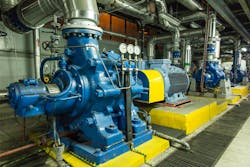The overall efficiency of a pump system can be defined as the ratio of the hydraulic output of the pump to the electrical energy input to its motor. It can be used to help identify opportunities for potential energy savings, process improvement and maintenance planning.
Overall pump efficiency can be calculated using measurements of motor power, pump inlet pressure, pump outlet pressure and pump flow. These measurements are usually not available in most plants and adding them permanently can be expensive. However, it is relatively easy to measure the motor power, pump inlet pressure and pump outlet pressure on a temporary basis by connecting electrical instruments and installing pressure measurement instruments on important pumps.
Installing flow measurement instruments can be more complicated to implement because fluid properties, operating conditions and materials of construction need to be considered for each desired measurement. Using a portable ultrasonic flowmeter is a viable option for some applications. However, these flowmeters have limitations and can produce inaccurate measurements at times.
Installing a full-bore flowmeter can be expensive, although the benefit of doing so sometimes outweighs the costs involved. Pumping configurations often consist of one operating pump that pumps a fluid from one location to one other location, sometimes by throttling a control valve to control, for example, the level in a tank. In these applications, installing a variable speed drive to operate the pump and eliminate the control valve can often generate sufficient energy savings to pay for a new flowmeter that can be used in a cascade control strategy to stabilize operation in addition to being used to calculate the efficiency of the pump system.
It is quite common to take an indirect approach to justify improvements.
David W. Spitzer is a regular contributor to Flow Control magazine and a principal in Spitzer and Boyes LLC, which offers engineering, seminars, strategic, marketing consulting, distribution consulting and expert witness services for manufacturing and automation companies. Spitzer and Boyes is also the publisher of the Industrial Automation INSIDER. He has more than 40 years of experience and has written more than 10 books and 350 articles about flow measurement, instrumentation and process control.
Spitzer may be reached at 845-623-1830 or via spitzerandboyes.com. Click on the “Products” tab to find his Consumer Guides to various flow and level measurement technologies.



